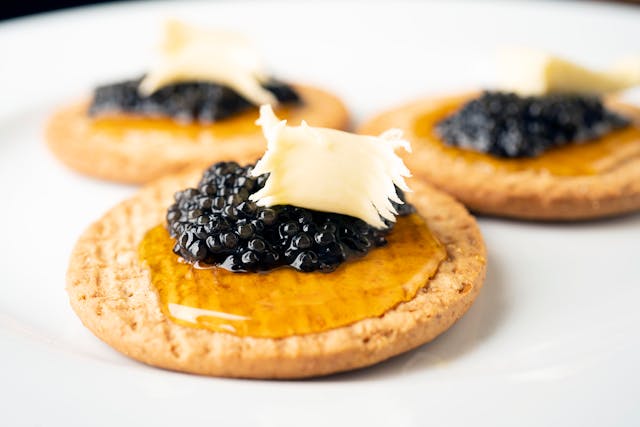Caviar, which is the processed egg or roe of sturgeon fish, is perhaps one of the earliest products that people linked with glamor and luxury. Originally associated with the wealthy, caviar was considered a food for royal celebrations and was a synonym for opulence. Today more people are interested in the taste and features of this product, which has long been recognized as an exotic meal-- a symbol of high status and affluence.
Understanding Caviar
Beluga, ossetra as well as sevruga are considered to be the most popular kinds of caviar that differ in specific features. Beluga caviar maturing involves large, delicate pearls that are associated with a luxurious, buttery taste. Ossetra has a small contrast of a nutty flavor and has larger grains in comparison with sevruga, which has highly concentrated small beads with extra saltiness. The size, color, and, to some extent, appearance is used to determine the quality of caviar. Better caviar is characterized by larger and more consistently sized eggs, which are also harder and shiny.
How to Choose Caviar
In order to select high-quality caviar, you must consider its freshness and origin. If you are buying true caviar, it comes packed in jars or tins and the label must tell where it comes from and what kind of sturgeon was used. Whereas, selecting from a brand should mean selecting quality, meaning the caviar should look whole and smell good. As with most things, caviar should be preserved by being kept in an environment that is relatively cool and dark or refrigerated if needed. The price of caviar might also differ considerably; as with diamonds or wine, the more expensive types could also be the most uncommon ones. For example, Beluga caviar is regarded to be very expensive because the sturgeon that is used for this product is very rare. Selecting caviar is, to some extent, a matter of taste paired with the question of how deep one’s purse strings can be loosened.
Serving Caviar
To savor caviar to its maximum potential, it should be consumed as close to its original state as possible. In the past, it was poured and served with crushed ice underneath it to maintain the correct temperature. It can be served with blinis, which are small round pancakes or toasted triangular bread, and it is usually garnished with crème fraîche, finely chopped onions or hard-boiled eggs. Do not use any metallic spoons or forks for serving caviar, since this commodity reacts to metal. It is preferable to use mother-of-pearl, bone, or plastic spoons on Irish lace tablecloths. Those are the serving portions, and one must ensure that the serving portion is a small amount since a little goes a long way. Common portion sizes are about 1 to 2 ounces per person, and portion sizes should be cited accordingly to avoid over portioning. This helps in making sure that the caviar is taken as a delicacy and does not overpower the palate.
Enjoying Caviar: Combinations and Sipping
Those who want to take their taste buds to a new level can combine caviar with other flavors that will complement it. Some of the most traditional ‘seemingly fitting’ partner foods include vodka or cold alcoholic champagne that subdue the flavors of the caviar to reveal their best facets. There are several ways to serve caviar, which can be considered quite exotic. For example, one can serve caviar with white wine or sushi. If you are going to take caviar, it must be allowed to dissolve on the tongue to have a rich taste. Over the first third of the tongue, it should be slightly sweet and salty; on the second third of the tongue, smooth and buttery. Chew slowly and think about the food that you are consuming and the taste of the food. A little experiment shows that more labor can be put into finding out how best to enjoy this gourmet dish, even in pairs, and methods of serving can be tried out.
Conclusion
Caviar is not just a classy food delicacy, but rather a food for a refined palate, a taste that reveals a whole new world. Whether you have enjoyed caviar for the first time or aim to better appreciate its unique flavor, knowing the various types of caviar, the methods of choosing and serving it, and its ideal accompaniment can be very useful. After reading this article, you will be armed with the knowledge of basic principles that would allow you to discover the wealth of the relations between caviar and taste, turning each meal into a celebration.





Comments